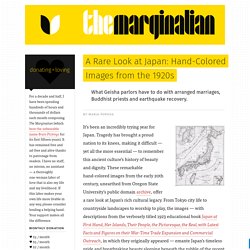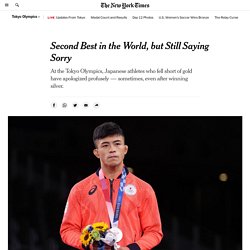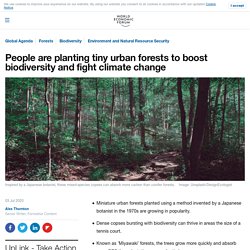

A Rare Look at Japan: Hand-Colored Images from the 1920s – The Marginalian. By Maria Popova It’s been an incredibly trying year for Japan.

Tragedy has brought a proud nation to its knees, making it difficult — yet all the more essential — to remember this ancient culture’s history of beauty and dignity. These remarkable hand-colored images from the early 20th century, unearthed from Oregon State University’s public domain archive, offer a rare look at Japan’s rich cultural legacy. From Tokyo city life to countryside landscapes to worship to play, the images — with descriptions from the verbosely titled 1923 educational book Japan at First Hand, Her Islands, Their People, the Picturesque, the Real, with Latest Facts and Figures on their War-Time Trade Expansion and Commercial Outreach, in which they originally appeared — emante Japan’s timeless pride and breathtaking beauty sleeping beneath the rubble of the recent devastation, awaiting awakening.
Princess Mako's Royal Wedding in Japan Goes Off With Little Fanfare. Overlooked No More: Kim Hak-soon, Who Broke the Silence for ‘Comfort Women’ How Public Criticism Has Affected Japan's Royal Women. Ancient DNA rewrites early Japanese history—modern day populations have tripartite genetic origin. Ancient DNA extracted from human bones has rewritten early Japanese history by underlining that modern day populations in Japan have a tripartite genetic origin—a finding that refines previously accepted views of a dual genomic ancestry.

Twelve newly sequenced ancient Japanese genomes show that modern day populations do indeed show the genetic signatures of early indigenous Jomon hunter-gatherer-fishers and immigrant Yayoi farmers—but also add a third genetic component that is linked to the Kofun peoples, whose culture spread in Japan between the 3rd and 7th centuries. Rapid cultural transformations The Japanese archipelago has been occupied by humans for at least 38,000 years but Japan underwent rapid transformations only in the last 3,000 years, first from foraging to wet-rice farming, and then to a technologically advanced imperial state. Genomic insights into key Japanese transformations. Zao Fox Village, a Sanctuary in Japan Where Foxes Roam Freely. Located near the city Shiroishi in the mountains of Miyagi, Japan, the Zao Fox Village (Zao Kitsune Mura) is a paradise for fox lovers.

Open since 1990, the village is a sanctuary for over a hundred animals, including six different breeds of foxes who roam freely. After paying a small admission fee, visitors can take a tour of a bunny petting zoo, horse stables, and an enclosed area where injured and young foxes are kept for their own safety. The main attraction, however, is the large, open preserve where foxes scamper, play, eat, and sleep. Many of the foxes approach humans with curiosity, eager to be fed or petted, but visitors should be mindful that the adorable creatures are still semi-wild, and so may bite if provoked.
Zao Fox Village, a Sanctuary in Japan Where Foxes Roam Freely. (1) “働く”の100年史|100 YEARS of WORK in JAPAN. The Bomb Didn’t Beat Japan … Stalin Did. The U.S. use of nuclear weapons against Japan during World War II has long been a subject of emotional debate.

Initially, few questioned President Truman’s decision to drop two atomic bombs, on Hiroshima and Nagasaki. But, in 1965, historian Gar Alperovitz argued that, although the bombs did force an immediate end to the war, Japan’s leaders had wanted to surrender anyway and likely would have done so before the American invasion planned for November 1. Second Best in the World at the Tokyo Olympics, but Still Saying Sorry. TOKYO — Kenichiro Fumita was crying so hard that he could barely get the words out.

“I wanted to return my gratitude to the concerned people and volunteers who are running the Olympics during this difficult time,” Mr. Fumita, a Greco-Roman wrestler, said between sobs after finishing his final bout at the Games this week. “I ended up with this shameful result,” he said, bobbing his head abjectly. “I’m truly sorry.” Mr. Artist Crafts Delicate Sculptures With Hundreds of Tiny Paper Cranes. Japanese artist Naoki Onogawa has been fascinated with the traditional art of origami since he was a child.

Now, he incorporates the popular craft into his own artwork. Using nothing more than his hands, the artist folds hundreds of tiny origami cranes that are small enough to fit on the tip of his finger. Those minuscule paper creatures are then used as leaves on the delicate branches of his asymmetrical tree-like sculptures. Onogawa began creating paper cranes after witnessing the devastating effects of the Great East Japan Earthquake in 2011. This Adorable Japanese Couple Spend Every Day in Matching Outfits. Whether it's an intentional decision or unexplainable couple telepathy, many loved-up duos dress to complement each other.

Famous examples include David and Victoria Beckham’s matching leather look from 1999, and of course no one could forget Britney Spears and Justin Timberlake’s iconic double-denim red carpet moment in 2001. However, there’s one married couple in Japan who is currently stealing the show. Known as bonpon on Instagram (Mr. Bon and Mrs. Pon or Tsuyoshi and Tomi Seki), have been married for 41 years, and they show their deep love to the world by dressing in matching outfits. 100-Year-Old Photos Capture Authentic Daily Life in Japan. These rare shots of vintage Japan during 1908 are thanks to the acute artistic eye of Arnold Genthe.

The German-born American scholar honed his photographic talent on the streets, spending his off-time roaming through his city with a partially hidden camera in attempts of recording memorable moments. This intriguing series was collected during a 6-month visit to Japan, during which Genthe managed to share his perspective of the vivid daily experiences of its local citizens. Born in Germany, Genthe pursued formal education in the field of philology before immigrating to San Francisco to work as a tutor. People are planting tiny urban forests to boost biodiversity and fight climate change.
Miniature urban forests planted using a method invented by a Japanese botanist in the 1970s are growing in popularity.

Dense copses bursting with biodiversity can thrive in areas the size of a tennis court. Known as 'Miyawaki' forests, the trees grow more quickly and absorb more CO2 than plantations grown for timber. How much space do you think you need to grow a forest? Japan's recovery from tsunami disaster, by the numbers. Japan's recovery from tsunami disaster, by the numbers By MARI YAMAGUCHI March 11, 2021 GMT TOKYO (AP) — Ten years after a massive earthquake and tsunami devastated Japan’s northeastern coast, triggering meltdowns at the Fukushima nuclear power plant, much has been achieved in disaster-hit areas but they are still recovering.

Numbers show how much progress has been made and what still remains. A Village Erased. The earthquake and tsunami of March 11, 2011, wiped away the ancient Japanese village of Kesen. In the past decade, a small group of survivors has valiantly tried to rebuild the community, but a grim reality has set in: This emptiness will last forever. KESEN, Japan — For centuries, this village rode the currents of time: war and plague, the sowing and reaping of rice, the planting and felling of trees. Then the wave hit. Time stopped. Japan’s Three Great Gardens. The aesthetic sense of old Japan lives on in its three most famous gardens. Japan’s “three great gardens”—Kairakuen, Kenrokuen, and Kōrakuen—were all created by daimyō (feudal lords) during the Edo period (1603–1868).
The sense of beauty from centuries past still has the power to inspire today. All three were created in the kaiyū (circuit) style, based around a central pond, that typifies the Edo period. People enjoyed the scenery while walking along garden paths, in contrast to zakanshiki gardens, which were designed to be viewed from indoor spaces such as the drawing rooms of palatial homes.
Sumo. Earthquakes - disasters. Hokusai and the wave that swept the world - BBC Culture. Rising in the East It’s worth recalling that what brought Hokusai and other ukiyo-e printmakers to the attention of Monet, Degas, Cassatt, and Lautrec were trade deals, on uneven terms, between Japan and the West. France and other industrial powers were thriving; Japan was in upheaval, as the shogunate gave way to the Meiji Restoration. So the exchange was uneven from the start, economically and culturally as well. Fukushima meltdown event.
Ukiyo-e woodblock prints in animated gifs click 2x wait for it. Aug 18, 2015 japanese artist brings ukiyo-e woodblock prints to life through animated gifs japanese artist brings ukiyo-e woodblock prints to life through animated gifs(above) katsushika hokusai’s ‘yoshida at tokaido’ animated all gifs courtesy of segawa thirty-seven from the 17th through 19th centuries, ukiyo-e woodblock prints and paintings populated the japanese art and cultural movement. artist katsushika hokusai popularized the trend with his series of ’36 views of mount fuji’, depicting scenes of the renowned mountain captured in different seasons and weather conditions, from a variety of different places and perspectives. these compositions were created through a cooperative effort of craftsman, who each adopted traditional techniques to sketch, carve and colorize the works.
History of japan. Japanese mythology. Japanese myths, as generally recognized in the mainstream today, are based on the Kojiki, the Nihon Shoki, and some complementary books. The Kojiki, or "Record of Ancient Matters", is the oldest surviving account of Japan's myths, legends and history. The Shintōshū describes the origins of Japanese deities from a Buddhist perspective, while the Hotsuma Tsutae records a substantially different version of the mythology. One notable feature of Japanese mythology is its explanation of the origin of the imperial family which has been used historically to assign godhood to the imperial line.
Asian Language Writing Systems. The Japanese who Came to Call Brazil Home. What Owning a Ramen Restaurant in Japan is Like. Okinawa. UNESCO World Heritage Sites in Japan. Japan, known as the endless discovery country for travelers, live up to its tagline with 17 UNESCO World Heritage Sites pack into this relatively small size. The sites range from historical to nature and to cultural. WORLD HERITAGE SITES - Japan Specialist. Skip to content. Black Lives Matter pushes Japan to confront racism. Image copyright Reuters To many Japanese, racism towards black people has long been considered something that happens in the US or Europe, not at home. Best UNESCO World Heritage Sites in Kyoto, Japan - Travel Caffeine. Vanishing without a trace.
Clash Of The Samurai: The History Of Japan's Genpei War - HistoryExtra. Impaled by an arrow, samurai general Minamoto Yorimasa knelt and wrote a farewell poem on his fan: “Like a fossil tree from which we gather no flowers, sad has been my life, no fruit to produce.” Accompanied by the symphony of ringing steel and bloodcurdling screams from the battle close by, the 74-year-old calmly pulled out his dagger and cut open his belly, leaving instructions for one of his men to throw his head into the river. 72 photos By Shin Noguchi. Expresses solidarity with Japan as fire rips through World Heritage site in Okinawa. Japanese Aesthetics. 1. Introduction Two preliminary observations about the Japanese cultural tradition to begin with. The first is that classical Japanese philosophy understands the basic reality as constant change, or (to use a Buddhist expression) impermanence.
This is a Japanese drum line! PHOTOGRAPHS OF HIROSHIMA AND NAGASAKI (GENSUIKIN) 1. The Huge Atomic Cloud / The Mushroom Cloud Blowing Up. Women protest judicial system after incestuous rapist walks free:The Asahi Shimbun. Hundreds of women in Tokyo protested two recent court rulings in which the judges recognized that rapes had occurred but allowed the perpetrators to walk because the victims could have offered more resistance. Dying Alone: Kodokushi, Japan's epidemic of isolation through the eyes of a 'lonely death' cleaner. Learn how to read japanese kanji! Hundreds flock to get historic newspaper in Tokyo on day Japan announces new imperial era.
(22) BEGIN Japanology - Moss. Thieves stole a rare 400-year-old bonsai from a Japanese garden. The grief-stricken owner offered care instructions. A Japanese Artist Depicts The Daily Life Of His Hamster, And It’s Adorable. Monmon Cats Tattooing Other Cats click 2x. BBC: Hokusai - Old Man Crazy to Paint (2017) 12 Things NOT to do in Japan. Yoko Kanno & Seatbelts - Cowboy Bebop (Original Soundtrack 3) Blue. Kyoto at night. Aichi - Heartland of Japan's Craft Traditions - CYCLE AROUND JAPAN. Portland Taiko & No-No Boy. Tokyo 2020: The Olympics of the Future (INFOGRAPHIC) 2 clicks. How a kingfisher, an owl, & a penguin helped redesign Japan's Shinkansen.
Kirie Octopus Cut From a Single Piece of Paper by Masayo Fukuda. Hot Spring Manners -How to bathe in a hot spring - A Paper Memo Pad That Excavates Objects as It Gets Used click 2x. Still life: Death and love dolls in Japan. Customers are asked to keep conversation to a minimum upon entering Leiya Arata’s home studio in Osaka. By the time make-up and costumes are done, they are expected not to utter a single word, their transformation into a doll now complete. “I wanted to be beautiful and be possessed by someone. Not to be dominated, but to be loved and cherished, like sex dolls are,” Ai Kaneko, a 39-year-old single nurse who travelled down from Tokyo, tells EPA. Kaneko says the ‘factory’ saved her life from suicidal thoughts she began to have 15 years ago after finding the body of her boyfriend, who had hanged himself. “For many years after my boyfriend’s death, I was very unwell. Arata’s unique services have provided her with more stability. NHK WORLD-JAPAN On Demand.
Kanji of the year, meaning 'disaster,' symbolizes 2018 amid natural and human calamities. Tokyo fish market Tsukiji. 11 Beautiful Japanese Words That Don't Exist In English. 鼓童「打男 DADAN」 Kodo "Dadan" Japan's first woman fighter pilot to blaze a trail in skies. Residents living permanently in Japan's cyber-cafés - Lost in Manboo. Time. 'Mini-storytellers': Japanese children pass on horror of Nagasaki bombings. Pictures of the Obon Festival of the Dead in Japan. 10 Ways JAPAN is 10 Years Ahead of the World. Driverless taxi debuts in Tokyo in 'world first' trial ahead of Olympics. Japan to end tourists' toilet trouble with standardised buttons. Japanese Precision Marching. Lone hero cares for abandoned animals of Fukushima. TOKYO APARTMENT - Shinjuku. Japanese Food Tour - HIDDEN-GEMS in Tokyo. Japan's Tokaido Shinkansen Bullet Train. Japan train departs 25 seconds early, company apologises for 'truly inexcusable' mistake, East Asia News & Top Stories - The Straits Times.
Japanese. Mysterious snow scenes in Japan. [Image] Find a reason for being. Girl Drummer at Japanese Mall! So Cool! The Children’s Book That Caused Japan’s Raccoon Problem. Japanese fans pick up trash after World Cup match. 'Dementia towns': how Japan is evolving for its ageing population. Tokyo Medical University faces government pressure to quickly disclose results of sex discrimination probe. Gives Birth In Japan, Shows Food She Was Fed In The Hospital. Brothels and blossom: Japan's grandest journey – in pictures click 2x. Exhibition of 8,000 Chopstick Sleeve Sculptures. When you don't know Japanese..... Ryūsendō Cave – Iwaizumi, Japan.
In The Art Of Netsuke, Tiny Toggles Tell Delightful Stories Of Japan. Funny Japanese Game Show Slippery Stairs.